Unit - 5
Wireless and Mobile Technologies and Protocols and their performance evaluation
Q1) What are IEEE802.11 standards and what other standards do they support?
A1) IEEE 802.11 is a set of standards carrying out wireless local area network (WLAN) computer communication in the 2.4, 3.6 and 5 GHz frequency bands. They are created and maintained by the IEEE LAN/MAN Standards Committee (IEEE 802)
802.11a — an extension to 802.11 that applies to wireless LANs and provides up to 54-Mbps in the 5GHz band. 802.11a uses an orthogonal frequency division multiplexing encoding scheme rather than FHSS or DSSS.
802.11b — an extension to 802.11 that applies to wireless LANS and provides 11 Mbps transmission in the 2.4 GHz band. 802.11b uses only DSSS. 802.11b was a 1999 ratification to the original 802.11 standard, allowing wireless functionality comparable to Ethernet.
802.11e — a wireless draft standard that defines the Quality of Service support for LANs, and is an enhancement to the 802.11a and 802.11b wireless LAN (WLAN) specifications. 802.11e adds QoS features and multimedia support to the existing IEEE 802.11b and IEEE 802.11a wireless standards, while maintaining full backward compatibility with these standards.
802.11g — applies to wireless LANs and is used for transmission over short distances at up to 54-Mbps in the 2.4 GHz bands.
802.11n — 802.11n builds upon previous 802.11 standards by adding multiple-input multiple-output. The additional transmitter and receiver antennas allow for increased data throughput through spatial multiplexing and increased range by exploiting the spatial diversity through coding schemes like Alamouti coding. The real speed would be 100 Mbit/s (even 250 Mbit/s in PHY level), and so up to 4-5 times faster than 802.11g.
Q2) Explain the difference between IEEE 802.11 and 802.16?
A2)
S.No. | 802.16 | 802.11 |
01. | IEEE 802.16 standard defines WiMAX. | IEEE 802.11 standard defines WLAN or WiFi. |
02. | It is designed for long distance/wide area. | It is designed for limited area. |
03. | It provides a coverage range of 7 km to 50 km. | It provides a coverage range of 30 m to 100m. |
04. | 802.16 standard is used for outdoor usage. | 802.11 standard is used for indoor usage. |
05. | It operates on frequencies of 2.4 GHz, 5 GHz. | It operates on frequencies of 2.5 GHz, 3.5 GHz, 5.8GHz. |
06. | Standard variants of 802.16 are 802.16a, 802.16d, 802.16e, 802.16m etc. | Standard variants of 802.11 are 802.11a, 11b, 11g, 11n, 11ac, 11ad etc. |
07. | It provides a data rate of 100 Mbps in a 20 MHz channel. | It provides a data rate of 54 Mbps in 20 MHz channel. |
08. | Large number of customers are connected to this as it covers a wide area. | Limited number of customers/devices are connected which are with in the limited range. |
09. | For encryption purpose it uses Data Encryption Standard with Advanced Encryption Standard. | For encryption purpose it uses Rivest Cipher 4. |
10. | Different QoS options are available like UGS, rtPS, nrtPS, BE, etc | It does not provide any QoS but Supported in IEEE 802.11e. |
11. | Bandwidths varies dynamically as per user requirement from 1.5 to 28 MHz. | Bandwidth variants are 20 MHz, 40MHz, 80MHz and 160 MHz. |
Q3) What are the mobile IP entities and technologies used in mobile IP?
A3) Mobile IP Entities
Following section defines several entities and terminologies used in mobile IP.
(i) Mobile node
- A MN (Mobile Node) is an router or end system that can change its point of attachment to the internet using mobile IP.
- Mobile node can be any device such as laptop or mobile phone. Mobile node have its IP address and can communicate with another systems.
(ii) Correspondent node
A CN can be a Mobile Node (MN) or it can be a fixed IP host linked to a router. CN can be consider as a communication partner and at least one partner is needed for the communication purpose.
(iii) Home network
HN is a network having an address prefix matching that of a mobile node’s home address. Mobile IP support is not needed within the home network.
(iv) Foreign network
The Foreign Network (FN) is the current subnet of the MN visits and which is not belongs to the home network.
(v) Foreign agent (FA)
- Foreign agent is used to provide the various services to the Mobile Node (MN), when MN visits to the foreign network.
- Foreign agent can have care-of-address (COA), that is acting as tunnel end points and forwarding the packets to the mobile node.
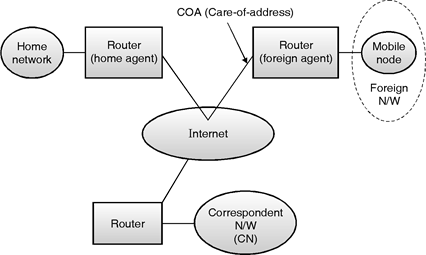
(vi) Care of address (COA)
- It is used to define the current location of mobile node from an IP point of view.
- All the IP packets sent to the MN are first delivered to the COA, that is not directly send to the IP address of the MN.
(vii) Home Agent (HA)
HA is located in home Network and provides various services for the mobile node. Home agent maintains a location registry that used to give MNs location by the current COA.
Q4) Explain IMT 2000 the third generation mobile services?
A4)
It is called international mobile telecommunication 2000. For indoor and outdoor operation it has high data rate. It is for symmetrical and asymmetrical data transmission. It can be implemented for circuit switched and packet switched services. It can be implemented for multimedia services.
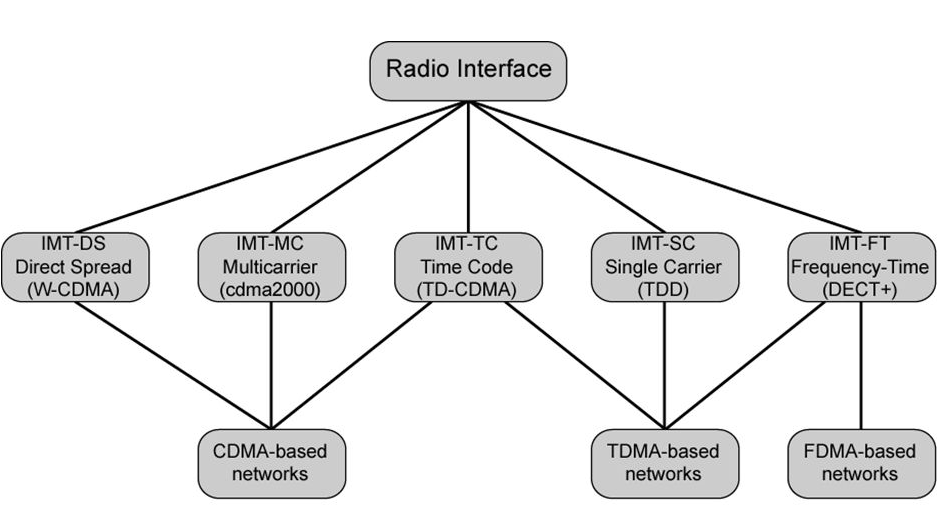
Fig 1. IMT Family structure
Q5) Explain the architecture of WCDMA network?
A5)
International mobile telecommunication-2000 is ITU globally co-ordinated term for 3G with some constraints like frequency spectrum uses and technical specifications.
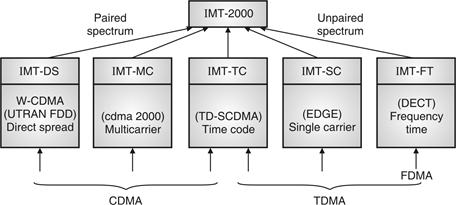
Fig. 2 Specification of IMT-2000 (radio interface)
Parameter | W-CDMA | IMT-2000 |
Carrier spacing | 5 MHz | 3.75 MHz |
Chip rate | 3.84 MHz | 3.6864 MHz |
Data modulation | BPSK | FW-QPSK RV-BPSK |
Power control | 1.6 KHz | 800 Hz |
Frame length | 10 ms/20 ms | 20 ms for data and control 5 ms for control information. |
Coherent detection. | No common pilot for downlink | Continuous and auxiliary pilot for down-link. |
Antenna beam foaming. | TDM dedicated pilot. | Auxiliary pilot. |
Forward link pilot. | TDM dedicated pilot. | CDM common pilot. |
Base station acquisition. | 3 steps: Slot, Frame, Code. | Time shifted PN correlation. |
Similarities :
- For higher data rate uses turbo code.
- Convolutional code used as baseline.
- Complex QPSK spreading on downlink.
- Soft handoff and mobile assisted procedure for inter frequency hard handoff proceed.
W-CDMA Features
Radio Interface
It occupy 5 MHz channels. It has format for synchronization, power control etc.
CDMA Technology
It allows multiple handset to get access at one base station same time. It uses DSSS for access.
Handover
It is handoff from one cell to another. Different strategies needed to handle inter-cell intra-cell movements of users lies under same or different BTS, MSC in handoff mechanism.
Network Architecture
Network architecture is designed in such a way that it support packet data transmission.
User equipment in W-CDMA are radio frequency circuitry, baseband processing, battery Universal Subscribers Identity Module (USIM).

Fig. 3 WCDMA network architecture overview
Q6) What are features of HSCSD?
A6)
- HSCSD stands for high-speed circuit switched data. It is enhanced version of circuit switched data; it helps to improve error correction in various level of quality of radio links.
- HSCSD provides data rate up to 14.4 kbps by using multiple time slot at same time. It transfers time sensitive images or video at high speed.
- In generate some latency compared to GPRS while in transmission of normal voice and data traffic.
Features
1. High speed circuit switched data technology gives four times faster compare to typical GSM networks.
2. 38.8 kbps speed for all type of non-voice application.
3. It work with multiple slot which makes allow for data transmission at higher rate.
4. With all standard conditions (UL, DL) user can attain 40 to 57.4 kbps in specific area.
Q7) Explain LTE network?
A7)
Long Term Evolution (LTE)
The current dominant cellular transmission technology. Superseding 3G, LTE is a 4G technology that uses the GSM software infrastructure but different hardware interfaces. LTE/4G will coexist with 5G for some time.
Download speeds in the U.S. Run the gamut from roughly 5 to 85 Mbps. Standardized in 2008, the first LTE smartphones appeared in 2011.
LTE provides global interoperability in more than three dozen frequency bands worldwide. However, no single phone supports all channels. Speed and other enhancements were made to the original LTE standard
LTE Is Based on IP Packets
In 3G and all prior cellular networks, voice was handled by the traditional circuit-switched network, and only data used the packet switched architecture of the Internet. However, LTE's Evolved Packet System (EPS) transmits both voice and data in IP packets. EPS comprises the OFDMA-based E-UTRAN air interface and
Evolved Packet Core (EPC).
In 2010, the ITU defined LTE, WiMAX and HSPA+ as 4G technologies. Previously, only LTE Advanced (LTE-A) was considered to be 4G. See LTE Advanced, LTE architecture, IP Multimedia Subsystem and 3GPP.
Q8) Explain working of GPRS?
A8) Working of GPRS
- SGSN:
It manages to send and receive of packet data to and from MS. It is useful for keeping track of mobile devices within scope of service area. It works in mobility management subscribed user verification and provides data required for billing.
- GGSN:
It has vital role of routing information whichever is necessary for tunneling Protocol Data Unit (PDUs). To SGSN to Serve Distinct MS. It is on interface for external PDNs. i.e. public data units like internet and X.25.
Charging gateway
- It maintains log entries for activities like data being transfer, change in charging terms in peak/off to peak and vice-versa, end of session for GPRS etc.
- It has collection records related to GPRS, usage in buffering of data, storage, transfer of data.
GTP
GPRS tunneling protocol uses to encapsulate IP or X.25 packet which are transferred among SGSN and GGSN.
Q9) Write short notes on 5G network?
5G is the new technology in the field of cellular network. It is the technology with many advantages over the old generation of cellular networks. It is designed such that it will increase the speed, reduce error and make it more flexible for wireless communication. It can offer speeds up to 2Gbps.
Working of 5G
This technology has improved architecture and also utilises the spectrum which was unused in 4G. The technology called Multiple input and multiple output abbreviated as MIMO is employed. This has many transmitters and receivers so that large data can be transferred. It is not just limited to new radio spectrum. It will have a software platform for networking. It will provide advancements in virtualization, cloud-based technology. The business process automation allows the 5G to be flexible enough to provide easy user access any time.5G networks can create software-defined subnetwork constructs known as network slices. These slices enable network administrators to dictate network functionality based on users and devices.
Architecture of 5G
The 5G model is based completely up on IP. There are various independent radio access technologies with a main user terminal. For outsider internet world each of the radio technologies is considered as the IP link. In order to get proper routing of IP packets related to some applications the IP technology is designed exclusively to get sufficient control. Moreover, to make accessible routing of packets should be fixed in accordance with the given policies of the user.
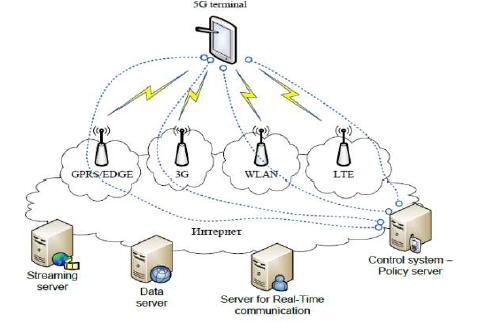
Fig 4. Architecture
The master core technology is basically used in present wireless network system. Due to this design, it becomes easy to operate parallel multimode which includes all the IP networks and 5G network mode. The network technologies such as RAN and DAT (Different Access Network) can be controlled easily through this mode. This mode is less complicated more efficient and powerful as it manages all the new deployments. World Combination Service Mode is being preferred because any service mode can be opened under this. This technology can be understood with a very basic example as when any teacher writes on board in any country it can be displayed on any other board in any other country except conversation and video.
Advantage of 5G
- It can utilise large bandwidth and offers high resolution.
- It is very efficient.
- Technology to facilitate subscriber supervision tools for the quick action.
- Most likely, will provide a huge broadcasting data (in Gigabit), which will support more than 60,000 connections.
- Easily manageable with the previous generations.
- Technological sound to support heterogeneous services (including private network).
- Possible to provide uniform, uninterrupted, and consistent connectivity across the world.
Q10) What is EDGE technology?
A10) Enhanced Data rates for Global Evolution (EDGE) introduces a new modulation technique, as well as protocol enhancements for transmitting packets over the radio.
The use of the new modulation and the protocol enhancements, result in dramatically increased throughput and capacity gains enabling 3G services in the existing GSM/GPRS networks. No changes are needed to the existing core network infrastructure to support EDGE. This emphasizes the fact that EDGE is only an “add-on” for BSS.
For EDGE, nine Modulation and Coding Schemes (MCS) are introduced (MCS1 to MCS9) and optimized for different radio environment. Four EDGE coding schemes are using GMSK and five are using 8 PSK Modulation.
Up gradation to EDGE
- Mobile Station (MS) − MS should be EDGE enabled.
- BTS − HW supplied is Edge enabled.
- BSC − Definitions for EDGE timeslots needs to be done in BSC.
- GPRS Support Nodes (GSNs) − Definitions for Edge need to be defined in GSNs.
- Databases (HLR, VLR, etc.) − No definition is required.
Benefits of EDGE
- Short-term benefits − Capacity and performance,
- Easy implementation on a GSM/GPRS network,
- Cost effective,
- Increases the capacity and triples the data rate of GPRS,
- Enables new multimedia services,
- Long-term benefit − Harmonization with WCDMA.
What EDGE Would Mean to Subscribers
- Streaming applications
- Very high speed downloads
- Corporate intranet connections
- Quicker MMS
- Video phone
- Vertical corporate applications - Video conference, Remote presentations.
Q11) Compare the 2.5G technologies?
A11)
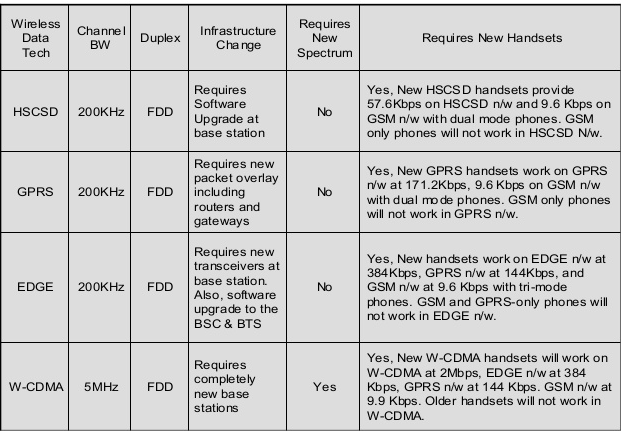
Q12) Explain the difference between wireless and wired transmission?
A12) Differences Between Wireless and Wired Transmission
- Address is not equivalent to physical location: In a wireless network, address refers to a particular station and this station need not be stationary. Therefore, address may not always refer to a particular geographical location.
- Dynamic topology and restricted connectivity: The mobile nodes may often go out of reach of each other. This means that network connectivity is partial at times.
- Medium boundaries are not well-defined: The exact reach of wireless signals cannot be determined accurately. It depends on various factors such as signal strength and noise levels. This means that the precise boundaries of the medium cannot be determined easily.
- Error-prone medium: Transmissions by a node in the wireless channel are affected by simultaneous transmissions by neighboring nodes that are located within the direct transmission range of the transmitting node. This means that the error rates are significantly higher in the wireless medium. We need to build a reliable network on top of an inherently unreliable channel. This is realized in practice by having reliable protocols at the MAC layer, which hide the unreliability that is present in the physical layer. Uses of WLANs Wireless computer networks are capable of offering versatile functionalities. WLANs are very flexible and can be configured in a variety of topologies based on the application. Some possible uses of WLANs are mentioned below.
- Users would be able to surf the Internet, check e-mail, and receive Instant Messages on the move.
- In areas affected by earthquakes or other such disasters, no suitable infrastructure may be available on the site. WLANs are handy in such locations to set up networks on the fly.
- There are many historic buildings where there has been a need to set up computer networks. In such places, wiring may not be permitted or the building design may not be conducive to efficient wiring. WLANs are very good solutions in such places.
Q13) Compare GSM and GPRS?
A13)
GSM Network Element | Modification or Upgrade Required for GPRS. |
Mobile Station (MS) | New Mobile Station is required to access GPRS services. These new terminals will be backward compatible with GSM for voice calls. |
BTS | A software upgrade is required in the existing Base Transceiver Station(BTS). |
BSC | The Base Station Controller (BSC) requires a software upgrade and the installation of new hardware called the packet control unit (PCU). The PCU directs the data traffic to the GPRS network and can be a separate hardware element associated with the BSC. |
GPRS Support Nodes (GSNs) | The deployment of GPRS requires the installation of new core network elements called the serving GPRS support node (SGSN) and gateway GPRS support node (GGSN). |
Databases (HLR, VLR, etc.) | All the databases involved in the network will require software upgrades to handle the new call models and functions introduced by GPRS. |
Q14) What are the design goals of WLANs explain?
A14) The following are some of the goals which have to be achieved while designing WLANs:
- Operational simplicity: Design of wireless LANs must incorporate features to enable a mobile user to quickly set up and access network services in a simple and efficient manner.
- Power-efficient operation: The power-constrained nature of mobile computing devices such as laptops and PDAs necessitate the important requirement of WLANs operating with minimal power consumption. Therefore, the design of WLAN must incorporate power-saving features and use appropriate technologies and protocols to achieve this.
- License-free operation: One of the major factors that affects the cost of wireless access is the license fee for the spectrum in which a particular wireless access technology operates. Low cost of access is an important aspect for popularizing a WLAN technology. Hence the design of WLAN should consider the parts of the frequency spectrum (e.g., ISM band) for its operation which do not require an explicit licensing.
- Tolerance to interference: The proliferation of different wireless networking technologies both for civilian and military applications and the use of the microwave frequency spectrum for non-communication purposes (e.g., microwave ovens) have led to a significant increase in the interference level across the radio spectrum. The WLAN design should account for this and take appropriate measures by way of selecting technologies and protocols to operate in the presence of interference.
- Global usability: The design of the WLAN, the choice of technology, and the selection of the operating frequency spectrum should take into account the prevailing spectrum restrictions in countries across the world. This ensures the acceptability of the technology across the world.
- Security: The inherent broadcast nature of wireless medium adds to the requirement of security features to be included in the design of WLAN technology.
- Safety requirements: The design of WLAN technology should follow the safety requirements that can be classified into the following: (i) interference to medical and other instrumentation devices and (ii) increased power level of transmitters that can lead to health hazards. A well-designed WLAN should follow the power emission restrictions that are applicable in the given frequency spectrum.
- Quality of service requirements: Quality of service (QoS) refers to the provisioning of designated levels of performance for multimedia traffic. The design of WLAN should take into consideration the possibility of supporting a wide variety of traffic, including multimedia traffic.
- Compatibility with other technologies and applications: The interoperability among the different LANs (wired or wireless) is important for efficient communication between hosts operating with different LAN technologies. In addition to this, interoperability with existing WAN protocols such as TCP/IP of the Internet is essential to provide a seamless communication across the WANs. 1.2.2 Network Architecture This section lists the types of WLANs, the components of a typical WLAN, and the services offered by a WLAN. Infrastructure Based Versus Ad Hoc LANs WLANs can be broadly classified into two types, infrastructure networks and adhoc LANs, based on the underlying architecture. Infrastructure networks contain special nodes called access points (APs), which are connected via existing networks.
- APs are special in the sense that they can interact with wireless nodes as well as with the existing wired network. The other wireless nodes, also known as mobile stations, communicate via APs. The APs also act as bridges with other networks. Ad hoc LANs do not need any fixed infrastructure. These networks can be setup on the fly at any place. Nodes communicate directly with each other or forward messages through other nodes that are directly accessible.
Q15) Explain 4G technology?
A15)
- 4G takes on a number of equally true definitions, depending on whom you are talking to. In simplest terms, 4G is the next generation of wireless networks that will replace 3G networks sometimes in future.
- In another context, 4G is simply an initiative by academic R&D labs to move beyond the limitations and problems of 3G which is having trouble getting deployed
And meeting its promised performance and throughput.
- In reality, as of first half of 2002, 4G is a conceptual framework for or a discussion point to address future needs of a universal high speed wireless network that will interface with wire line backbone network seamlessly.
- 4G is also represents the hope and ideas of a group of researchers in Motorola, Qualcomm, Nokia, Ericsson, Sun, HP, DoCoMo and other infrastructure vendors who must respond to the needs of MMS, multimedia and video applications if 3G never materializes in its full glory.
Motivation for 4G Research Before 3G Has Not Been Deployed?
- 3G performance may not be sufficient to meet needs of future high-performance applications like multi-media, full motion video, wireless teleconferencing. We need a network technology that extends 3G capacities by an order of magnitude.
- There are multiple standards for 3G making it difficult to roam and interoperate across networks. We need global mobility and service portability
- 3G is based on primarily a wide-area concept. We need hybrid networks that utilize both wireless LAN (hot spot) concept and cell or base-station wide area network design.
- We need wider bandwidth
- Researchers have come up with spectrally more efficient modulation schemes that cannot be retrofitted into 3G infrastructure
- We need all digital packet networks that utilize IP in its fullest form with converged voice and data capability.
Reasons to Have 4G
- Support interactive multimedia services: teleconferencing, wireless Internet, etc.
- Wider bandwidths, higher bit rates.
- Global mobility and service portability.
- Low cost.
- Scalability of mobile networks.
What's New in 4G?
Entirely packet-switched networks.
- All network elements are digital.
- Higher bandwidths to provide multimedia services at lower cost (up to 100Mbps).
- Tight network security.
Q16) Explain the need applications, advantage and disadvantages of 4G?
A16)
Need of 4G:
- Firstly 3G’s maximum data transfer rate of 384 kbps to 2 mbps is much slower than 20mbps to 100mbps of 4G.
- With its use of existing technologies & communication standards, 4G present a comparably inexpensive standard.
- 4G will utilize most of the existing wireless communication infrastructure
Applications:
- 4G will provide for a vast no. Of presently nonexistent application for mobile devices.
- 4G device will differ from present day mobile device in that there will be navigation menus.
- 4G will provide a seamless network for users who travel & required uninterrupted voice/data communication.
Advantages and Disadvantages of 4G:
Advantages:
- Support for interactive multimedia voice, streaming video, internet & other broadband services.
- IP based mobile system.
- High speed, high capacity & low cost per bit.
- Global access, service portability & scalable mobile services.
- Better scheduling and call admission control technique.
- Ad-hoc & multi-hop network.
- Better spectral efficiency.
- Seamless network of multiple protocols & air interfaces.
Disadvantages:
- Expensive
- Battery uses are more hard to implement
- Need complicated hardware.
Q17) What are the qualities and services provided by 3G networks?
A17) Third generation (3G) is the generic term used for the next generation of mobile communications systems. These have been created to support the effective delivery of a range of multimedia services. In addition, they provide more efficient systems for the over-the-air transmission of existing services, such as voice, text and data that are available today.
3G wireless technology represents the convergence of various 2G wireless telecommunications systems into a single global system that includes both terrestrial and satellite components. One of the most important aspects of 3G wireless technology is its ability to unify existing cellular standards, such as CDMA, GSM, and TDMA, under one umbrella.
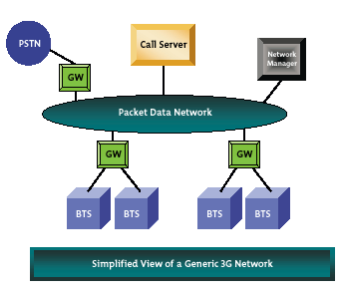
3G wireless networks consist of a Radio Access Network (RAN) and a core network. The core network consists of a packet-switched domain, which includes 3G SGSNs and GGSNs, which provide the same functionality that they provide in a GPRS system, and a circuit-switched domain, which includes 3G MSC for switching of voice calls.
3G: what's new?
A wide range of market-focused applications
Long-term market-driven creativity, an innovative value chain and real user benefits, driving genuine market demand
Advanced, lightweight, easy-to-use terminals with intuitive interfaces · Instant, real-time multimedia communications
Global mobility and roaming
A wide range of vendors and operators, offering choice, competition and affordability
High-speed e-mail and Internet access
3G enabled users to transmit voice, data, and even moving images. In order to realize these services, 3G improves the data transmission speed up to 144Kbps in a high-speed moving environment, 384Kbps in a low-speed moving environment, and 2Mbps in a stationary environment. 3G provides services like Internet connection, transmission of large-scale data and moving contents photographed by digital cameras and videos, and software downloading.
At present, maximum data transmission speed is 64Kbps offered in 3G services, and it was expected that by toward early 2001, 384Kbps would be possible. At the early stage of 3G services, a 144Kbps-transmission speed is expected. By around 2005 when 3G is in general use; a maximum speed of 2Mbps will be possible.
Q18) Explain the simulation techniques of wireless networks?
A18) Simulation is a technique used for executing the network on to the computer and with this, the behavior of the network is calculated with the help of some mathematical calculations that are used by network organizations. They are used to allow the researchers to develop, test and diagnose network scenarios that are difficult to simulate in the real world. It is basically used to test the new networking protocols or to change the existing protocols under controlled and reproductive environment. Different types of topologies can be designed by using various types of nodes (host, bridges, routers, hubs and mobile units etc.
Now a days information society is continuing to emerge and demands for the growth of wireless communication. So, for that purpose, future generation wireless networks are necessary to considered with their increasing necessities. The Future generation wireless networks are characterized by a distributed, dynamic, self-organizing architecture. These networks are mainly classified into different types based upon some specific characteristics viz Cognitive Radio Networks, Ad-Hoc/Mesh Networks, Sensor Networks, etc are shown in Figure. These wireless networks are used in various applications viz business, healthcare, military, gaming etc. The exposure of wireless networking has created many open research issues in network design too and many researchers are trying their best in designing the future generation wireless network.
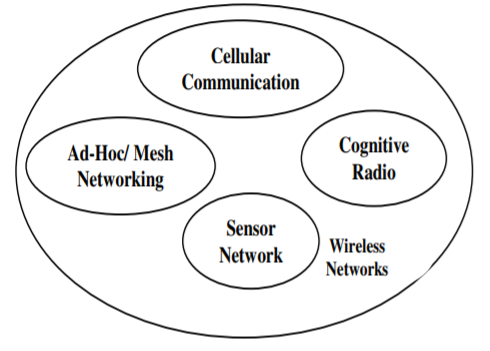
Fig 5. Different kinds of Wireless Networks
For analysing the performance of wireless networks as well as wired network, three techniques are used; analytical methods, simulation by computer and test bed measurement or physical measurement. In analytical method, attempts have been made to find the analytical solution to problems with the help of some initial conditions and set of parameters. However, it is a very complex method because lots of mathematical analysis has been done at each layer. Therefore, it is also known as comprehensive model for wireless ad-hoc networks. Also, the construction of test bed for any pre-set network is very costly, un-bearable task and requires a lot of efforts.
However, Simulation by computers is the most common method and has proven to be a valuable tool for developing and testing new protocols for wireless network where analytical method is neither applicable nor feasible. Researchers commonly use simulation method for analysis the performance of a system. Simulators are used for the many reasons like lower in cost, ease of implementation and practicality of testing large-scale networks. The main aim of simulators is to attain as real as possible situation in order to make the obtainable result realistic as well as adaptable.
In wireless network simulation, three important points have to be considered; firstly, the protocols and algorithms should be free from errors and have been implemented in details, secondly the simulation environment should be realistic and in addition to that a genuine method is used to analyse the collected data. However, it still has some potential pitfalls. So, to overcome these, it is necessary to know about different tools that are available and came to know about their benefits and drawbacks. The basic steps to run a simulation are as shown in Figure.
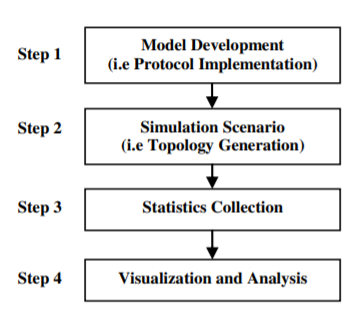
Fig. 6 Simulation Steps
The first step is to implement a protocol (that is model development); second step is to create a simulation scenario (that is designing a network topology and traffic scenario); third step is the collection of statistics and finally the fourth step is to visualize and analyse the simulation results which is carried out during or after the execution of simulation. The main problem with this method is that no one can make a guess in advance that how many times this process should be repeated to have a minimal error. And if the error is found out to be large then this process needs to be repeated. Simulation tools are classified into several norms which are as shown in Figure.
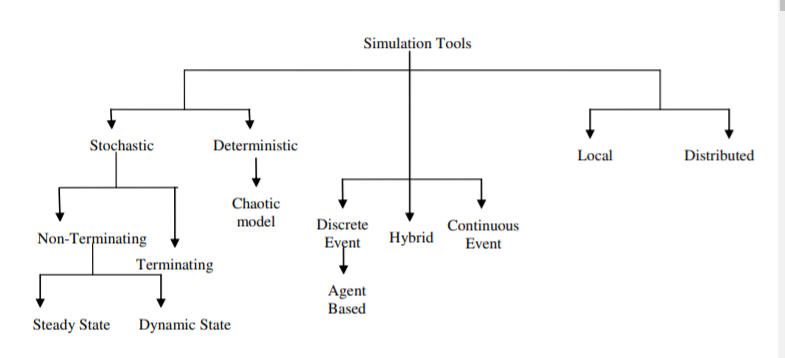
Fig. 7 Classification of Simulation Tools
A. Stochastic simulation: Stochastic simulation tool is one of the most realistic simulation tools that will include some randomness along with some time elapsing elements. The main applications of such simulations are to propose a model to observe the traffic pattern in some particular grid, customer service centers, and many more.
B. Deterministic simulation: Deterministic simulations are fixed and non random values that are used to define model of the system which is under investigation. The output of such system is fixed according to some specific inputs because of no randomness. Example: Chaotic model.
C. Terminating simulation: Terminating system may be defined as systems which have some natural event to occur and have some established starting and terminating condition. For example: A working day in an office starts at 9 am in morning and ends at 5 pm in evening. In such systems, the established conditions generally affect some measurement in performance. So its basic function is to understand the behavior of the transient system.
D. Non-Terminating simulation: Non-Terminating systems are those systems that do not have a finite duration. For Example: The Internet. These simulation tools are used to explore long term behavior of systems. Of-course such type of systems stops at some point but it is a non-trivial problem to determine proper time.
E. Steady State simulation: Steady State simulation models are used to define the relationship between elements of system and the state in which equilibrium state occurs in system with the help of some equations.
F. Dynamic simulation: Dynamic simulation models are those models which results in change in system as input signals changes.
G. Discrete event simulation: Discrete event simulations are those models which organize events on time basis. In such type of simulations, a queue of events has been made by simulator on the basis of time in which they occur. Then the simulator reads the event queue by queue and new event is entered as the previous one is executed. Most of simulation tools came under this category like computers, fault-tree and logic-test simulators. Agent Based simulators is a special case of this simulator in which mobile entities are known as agents. However, in case of traditional discrete event model, entities have only attributes but agents have both attributes as well as methods which includes rules for interacting with other agents.
H. Continuous Event simulators Continuous simulators are of opposite nature as compared with discrete simulators as they solve differential equations which show the evolution of system using continuous equations. Such type of simulation works continuously and smoothly with any information rather in discrete steps. For- Example: The movement of water through chain of pipes and reservoirs can be described by continuous simulator.
I. Hybrid Simulators Hybrid simulations are those tools which combine both the features of continuous as well as discrete simulators and it can solve differential equations only if it is superimpose on continuous systems.
J. Local simulators Local simulator models are those models which run within an interconnected network or on individual machine.
a. Distributed simulators Distributed simulator models are those models which run over a network of interconnected computers basically through the Internet. So, the simulation which scattered over many host computers is referred to known as distributed simulations.